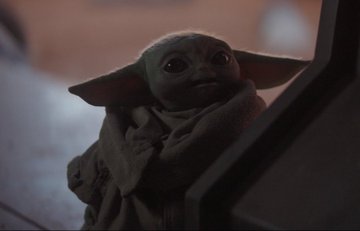Our brains have evolved to love this thing.
–
There is a new king and his name is Baby Yoda.
For the uninitiated, Baby Yoda is an unnamed 50-year-old toddler who enjoys eating frogs and playing with the Force on Star Wars TV show The Mandalorian. IRL, Baby Yoda is a puppet that turns people’s brains into cotton-candy goo.
When Star Wars gifted the world the also-cute Porgs in 2017, people were divided over whether or not cuteness even belonged in the Star Wars universe. Now, the internet is full of people happily declaring they would “die for Baby Yoda.” So why the full embrace of a green gremlin dressed in monk robes? Turns out, Baby Yoda is exactly what we humans have evolved to love.
Katherine Stavropoulos, assistant professor at University of California, Riverside, studies how cuteness triggers the brain’s neural reward system. She tells Inverse that Baby Yoda is prototypically cute. Stavropolous personally thinks “he’s adorable” and wants “to give him a huge hug.”
Baby Yoda’s features — huge eyes, tiny nose, big head, and small chin — are infantile-looking features we are pre-programed to melt over, because they trigger a care-taking response, she says.
This set of features is also known as “baby schema.” When we see babies, especially those with “high baby schema,” or especially big eyes and round faces, the brain’s reward system activates. This response also happens when we see baby animals that share these features — think of wide-faced red pandas, or large-eyed French bulldogs.
Dr. Wenda Trevathan, Regent’s Professor Emerita at New Mexico State University, tells Inverse that a primary reason human infants are so cute is that it “motivates others, especially moms and dads, to expend extraordinary effort to care for and raise them.”
I would die for baby Yoda and that’s not an overstatement #TheMandalorian pic.twitter.com/xAPb3gAVaP
— Kate H. Barnes (@katehbarnes) November 16, 2019
Eye-size relative to head-size is a cute-trigger for adult humans, but plumpness plays a role, too, Trevathan says. She thinks Baby Yoda looks similar to tarsiers, small primates which, she says, are “famously cute because of their large eyes” and “among the ‘cutest’ animals I’ve ever seen.”
An air of helpless and dependency also trigger parenting responses, she says. But that doesn’t mean babies are completely helpless: They may need our help because of their immature motor development and lacking locomotive skills, but “they have a lot of power because of their abilities to engage with adults through eye contact and babbling,” she says.
Which begs the question: What power will Baby Yoda have over the Mandalorian (apart from actual Force power)? Will Baby Yoda’s cuteness trigger him to give up his bounty-hunting life and protect the little guy? Upcoming episodes will reveal all, but the science suggests yes.
(For the source of this, and many other curiously weird articles, please visit: https://www.inverse.com/article/61113-baby-yoda-cute-brain-response/)













